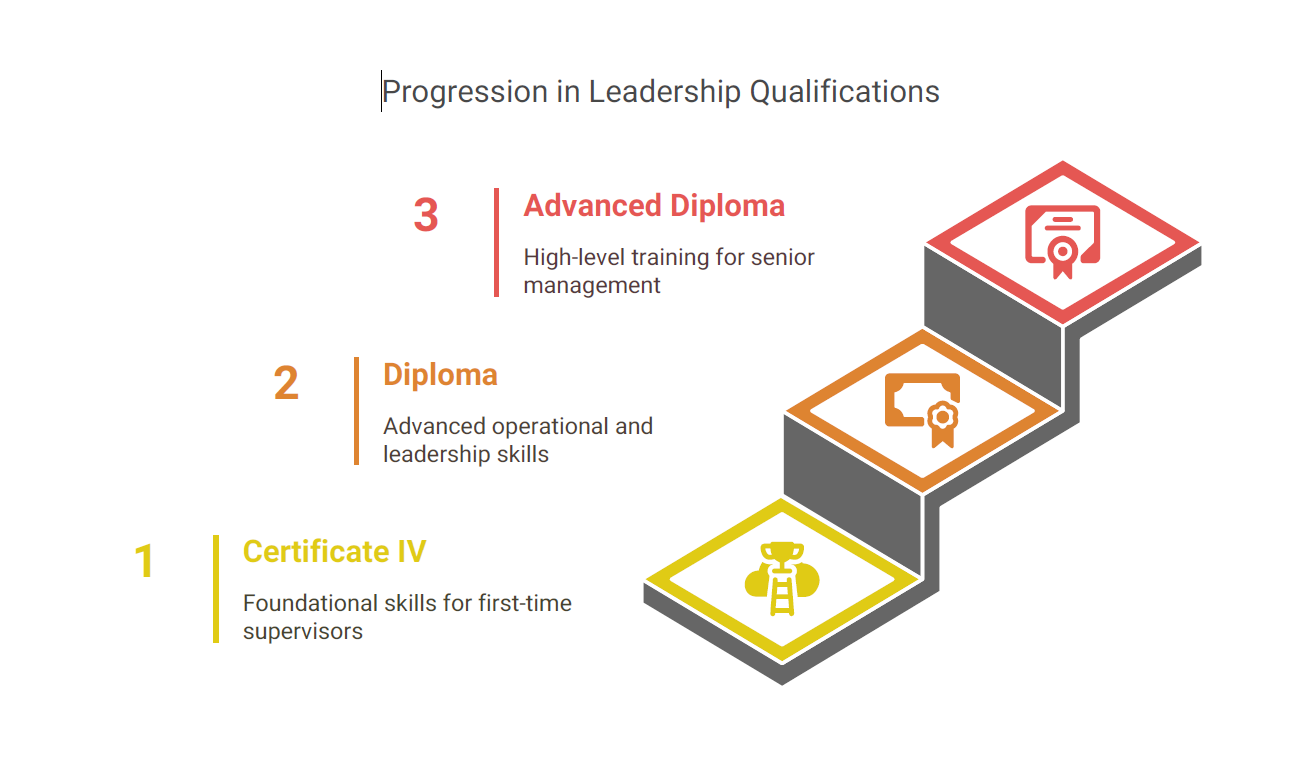One of the most frequent questions about Leadership and Management qualifications is whether they genuinely enhance earning potential. Although no qualification guarantees a specific salary bump—given variables like location, industry, and years of experience—a structured credential can give you a competitive edge. This article breaks down how each level (Certificate IV, Diploma, Advanced Diploma) typically correlates with pay scales, the real-world factors that influence results, and why these qualifications remain a valuable investment for many professionals aiming to increase their income.

Certificate IV Leadership and Management (BSB40520)
For those entering supervisory or team-leading roles, the Certificate IV often provides an initial pay boost. It validates your ability to delegate tasks, resolve conflicts, and maintain smooth daily operations. While the Australian Bureau of Statistics (ABS) doesn't supply a one-size-fits-all figure, many who step into Cert IV-level management see a 5–10% salary increment over non-qualified colleagues, especially in settings like hospitality, construction, or retail.
This might not catapult you into an executive salary bracket, but it offers a more assured stepping stone if you're transitioning from a hands-on role. Employers appreciate frontline managers who can adapt swiftly, so the practical focus of Cert IV often yields immediate, if modest, financial returns.
Diploma of Leadership and Management (BSB50420)
Moving from frontline oversight to more expansive responsibilities, the Diploma can raise your profile with both current and prospective employers. Diploma-level training covers broader leadership competencies such as operational planning, team development, and risk management. Roles like department manager or project coordinator become more accessible.
In terms of earnings, a Diploma can push annual salaries into the AUD $65k–$90k range in many industries, translating to around a 10–20% pay rise compared to mid-level professionals without formal credentials. This leap reflects the added complexity of tasks—like handling budgets, managing multiple sub-teams, or aligning daily operations with strategic objectives.
Advanced Diploma of Leadership & Management (BSB60420)
If your ambition involves steering entire departments, shaping organisational policies, or overseeing multi-million-dollar projects, the Advanced Diploma could be your best bet. Senior roles often link to salaries above AUD $90k, with potential to climb beyond AUD $120k depending on the sector. Advanced Diploma coursework delves into long-term planning, innovation, and organisational change, equipping you to handle complexities that demand significant strategic insight.
Of course, not every Advanced Diploma graduate immediately lands a high-paying position. Much depends on years of relevant experience, networking, and the competitiveness of your field. Yet, it's fair to say that an Advanced Diploma positions you more credibly for promotions into the senior leadership echelons.
Think about it this way: statistically, in 1 year you are likely to repay the full investment in your course—that is a 100% ROI. In subsequent years you are not repaying the investment so the ROI is in excess of 100% year on year. Good luck at finding any investment with this kind of return anywhere else.
Investing in Yourself is truly the best return on investment on the planet full stop!
Other Factors That Influence Your Pay Rise
While qualification level is significant, several other factors affect your potential salary increase:
- Industry and Sector: Mining, IT, and finance historically pay more for managerial roles than, say, smaller non-profits or local retail.
- Geographical Location: Metropolitan hubs like Sydney or Melbourne often offer higher salaries, albeit with a higher cost of living.
- Performance and Soft Skills: Two employees might share a qualification, but the one who demonstrates stellar communication and emotional intelligence usually commands a better package.
- Company Size and Budget: Larger corporations might have more robust pay scales, while small-to-medium enterprises (SMEs) sometimes compensate with flexible benefits rather than high base salaries.
Key Strategies to Maximise Your Pay Rise
- Combine Formal Learning with Real-World Achievements: Highlight specific projects you've completed—like reducing costs or launching a new service—to complement your qualification.
- Negotiate Confidently: Leverage the fact you've invested in professional development during performance reviews or job interviews.
- Stay Updated: Leadership theories evolve; attend workshops or pursue micro-credentials even after earning your Diploma or Advanced Diploma to remain relevant.
- Network Effectively: Building strong professional relationships through RTO meet-ups or industry events can reveal higher-paying opportunities.
Realistic Expectations
While a leadership qualification can influence your earning capacity, it's not a magic wand. If you're brand-new to management, you might need a year or two of hands-on experience post-Certificate IV before you notice a substantial wage increase. Similarly, an Advanced Diploma graduate entering a highly competitive market might find the pay bump slower to materialise.
However, these courses do put you on a faster track by formalising your skills, boosting your credibility, and furnishing a language for articulating managerial competencies. Employers often see a direct correlation between a staff member's advanced skill set and organisational efficiency or profitability. Over time, your ability to demonstrate measurable value—like leading successful projects or achieving cost savings—will likely translate into higher compensation.
Conclusion
Predicting an exact pay rise from completing a Certificate IV, Diploma, or Advanced Diploma in Leadership and Management is impossible due to the unique interplay of your industry, location, your experience, and personal drive. Yet, the general trend holds: each ascending qualification opens doors to more complex roles with typically higher salary brackets. A Certificate IV can be a quick route to frontline leadership with a modest pay uptick, a Diploma may unlock mid-tier managerial jobs and a 10–20% gain, and an Advanced Diploma positions you for senior leadership trajectories that can exceed AUD $90k or even $120k.
Crucially, how you use your qualification—applying new theories at work, networking strategically, and documenting achievements—plays a significant role in the final outcome. By pairing structured VET learning with real-world performance, you bolster your case for a meaningful salary boost. In that sense, your efforts to refine both operational and interpersonal expertise will likely pay off in more ways than one, from immediate job satisfaction to long-term financial gains.